
Orchids are plants that belong to the family Orchidaceae, a diverse and widespread group of flowering plants with blooms that are often colourful and fragrant. Orchids are cosmopolitan plants that are found in almost every habitat on Earth except glaciers. The world's richest diversity of orchid genera and species is found in the tropics.
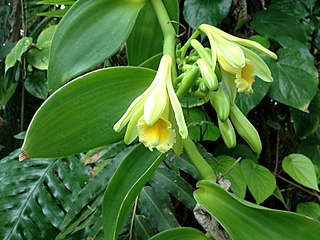
Vanilla is a spice derived from orchids of the genus Vanilla, primarily obtained from pods of the flat-leaved vanilla (V. planifolia).

Vanda, abbreviated in the horticultural trade as V., is a genus in the orchid family, Orchidaceae. There are 90 species, and the genus is commonly cultivated for the marketplace. This genus and its allies are considered to be among the most specifically adapted of all orchids within the Orchidaceae. The genus is highly prized in horticulture for its showy, fragrant, long-lasting, and intensely colorful flowers. Vanda species are widespread across East Asia, Southeast Asia, and New Guinea, with a few species extending into Queensland and some of the islands of the western Pacific.

Phalaenopsis, also known as moth orchids, is a genus of about seventy species of plants in the family Orchidaceae. Orchids in this genus are monopodial epiphytes or lithophytes with long, coarse roots, short, leafy stems and long-lasting, flat flowers arranged in a flowering stem that often branches near the end. Orchids in this genus are native to Asia, New Guinea, and Australia, but mostly occur in Indonesia and the Philippines.

Vanilla, the vanilla orchids, forms a flowering plant genus of about 110 species in the orchid family (Orchidaceae). This evergreen genus occurs worldwide in tropical and subtropical regions, from tropical America to tropical Asia, New Guinea and West Africa. Five species are known from the contiguous United States, all limited to southern Florida.
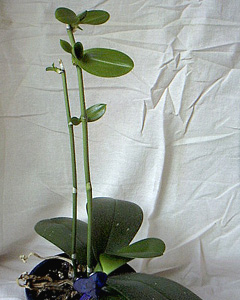
In horticulture, a keiki is a plant produced asexually by an orchid plant, especially Dendrobium, Epidendrum, and Phalaenopsis orchids. The baby plant is an exact clone of the mother plant, sometimes flowering while still attached to the mother. The word keiki is Hawaiian for 'baby' or 'child', literally meaning 'the little one'.

Hand pollination, also known as mechanical pollination is a technique that can be used to pollinate plants when natural or open pollination is either undesirable or insufficient.

The ornamental orchid species Phalaenopsis hieroglyphica is native to certain islands of the Philippines. Its flowers are creamy white with transverse markings that resemble glyphs. Through hybridization, growers have successfully created flowers with different shapes and colors while retaining the glyphs. Since 1975, the species has been protected under Appendix II of the Convention on International Trade in Endangered Species of Wild Fauna and Flora (CITES).
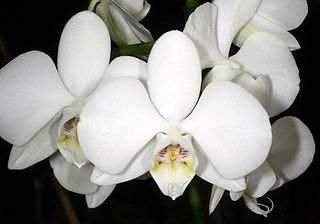
Phalaenopsis amabilis, commonly known as the moon orchid, moth orchid, or mariposa orchid, is a species of flowering plant in the orchid family Orchidaceae. It is widely cultivated as a decorative houseplant. It is an epiphytic or lithophytic herb with long, thick roots, between two and eight thick, fleshy leaves with their bases hiding the stem and nearly flat, white, long-lasting flowers on a branching flowering stem with up to ten flowers on each branch.
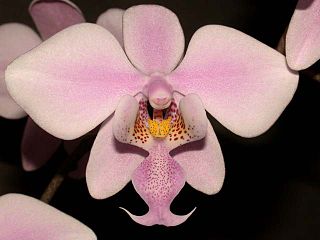
Phalaenopsis is a plant of the orchid genus Phalaenopsis and an endemic species to Philippines. It is commonly cultivated as a decorative houseplant. It is an epiphytic herb with long, thick roots, and mottled, fleshy leaves, and large, pink flowers. Mature plants can produce more than 100 flowers.

Phalaenopsis equestris is a flowering plant of the orchid genus Phalaenopsis and native to Philippines and Taiwan. The inflorescence has 10 to 20 flowers of about 25 mm (1 in) diameter.
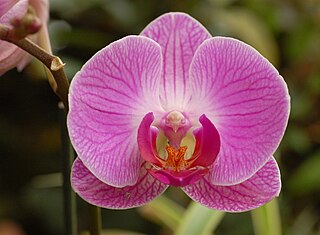
× Doritaenopsis was a genus of artificial hybrids first formally described in 1935 by André Guillaumin in the Archives du Muséum national d'histoire naturelle.
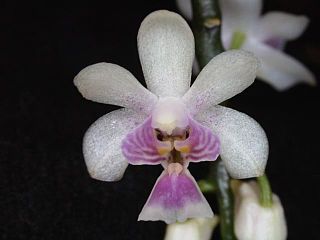
Phalaenopsis deliciosa is a species of orchid occurring from the Indian subcontinent to Malesia and China. The species is a miniature epiphytic herb. The leaves are unique due to their undulate margins. This characteristic greatly simplifies the identification of the species, even when specimens are not currently flowering. The small flowers are usually slightly pink, but white and yellow forms exist as well. Old inflorescences, which are usually panicles or more rarely racemes, may continue to grow and form new flowers over several flowering periods.

Phalaenopsis gigantea is a species of orchid endemic to the island of Borneo and was first described in 1909. The specific epithet gigantea refers to the giant size of its fleshy leaves, which can grow to over 60 cm in length on a mature plant. It is the largest known Phalaenopsis species.
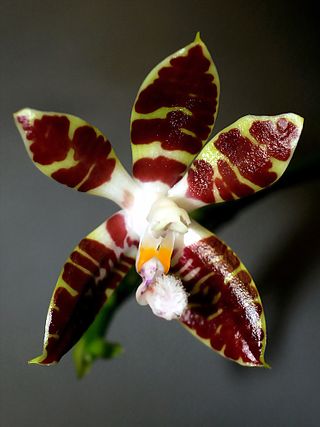
Phalaenopsis sumatrana is a species of orchid native to peninsular Thailand, Vietnam and southern Sumatra.
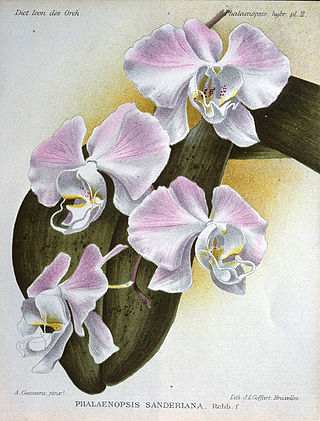
Phalaenopsis sanderiana is an orchid in the genus Phalaenopsis that is native to the Philippines. It was named in honour of M. Fredrick Sander. It is a pendant growing epiphyte with epileptic, rounded tip pendulous leaves. Inflorescence are showy of 15 to 20 on 32 inch long raceme.
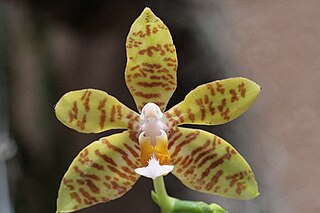
Phalaenopsis amboinensis, also known as the month Sulawesi orchid, is a species of monopodial epiphytic orchid flower native to eastern Indonesia.

Phalaenopsis javanica is a species of orchid native to Java and Sumatra. The specific epithet javanica refers to the Indonesian island Java.

Phalaenopsis kapuasensis, also known as the Kapuas Hulu Phalaenopsis, is a species of orchid endemic to Borneo. The specific epithet kapuasensis refers to the indonesian locality Kapuas Hulu, from which the type specimen was obtained.



















